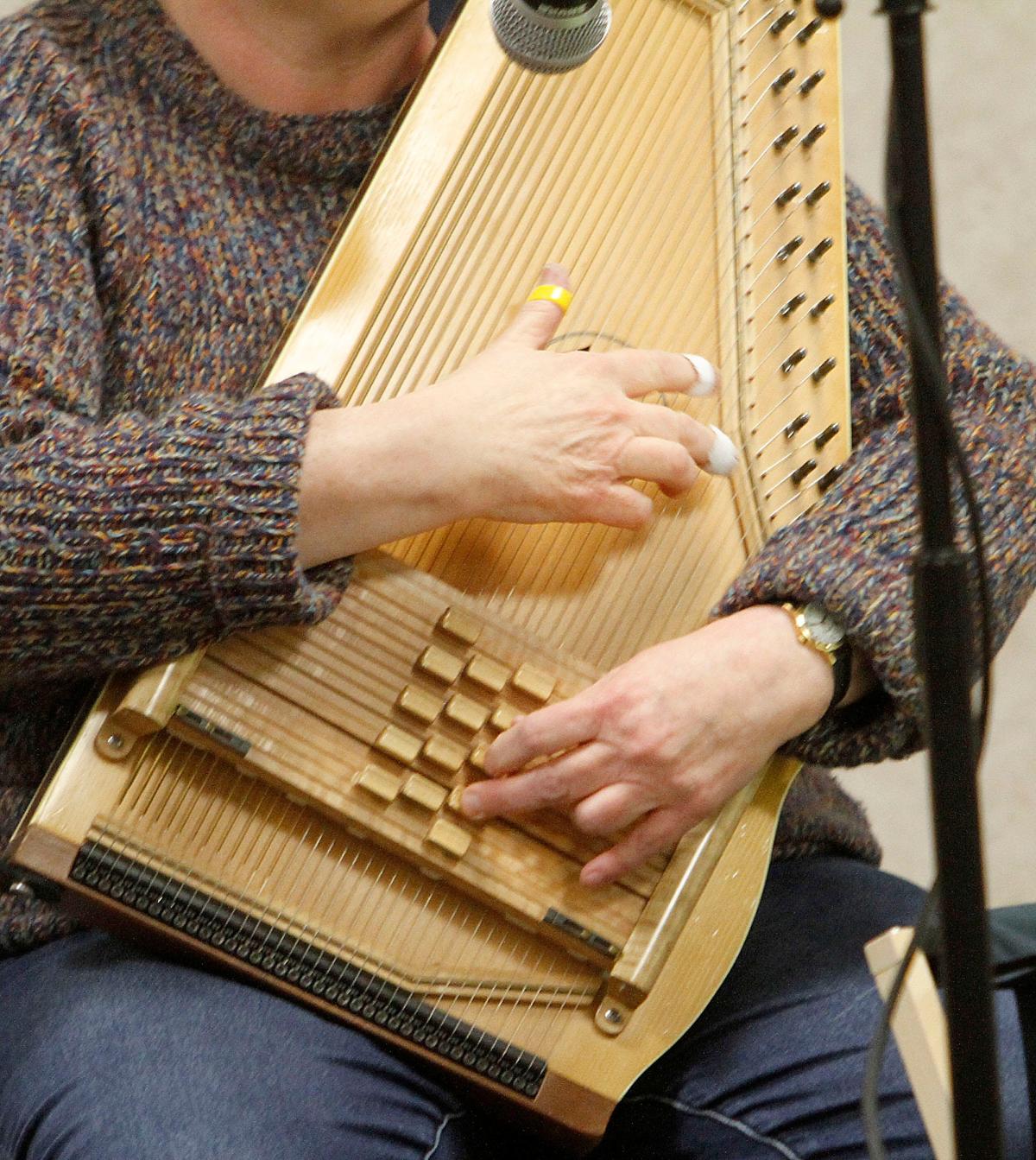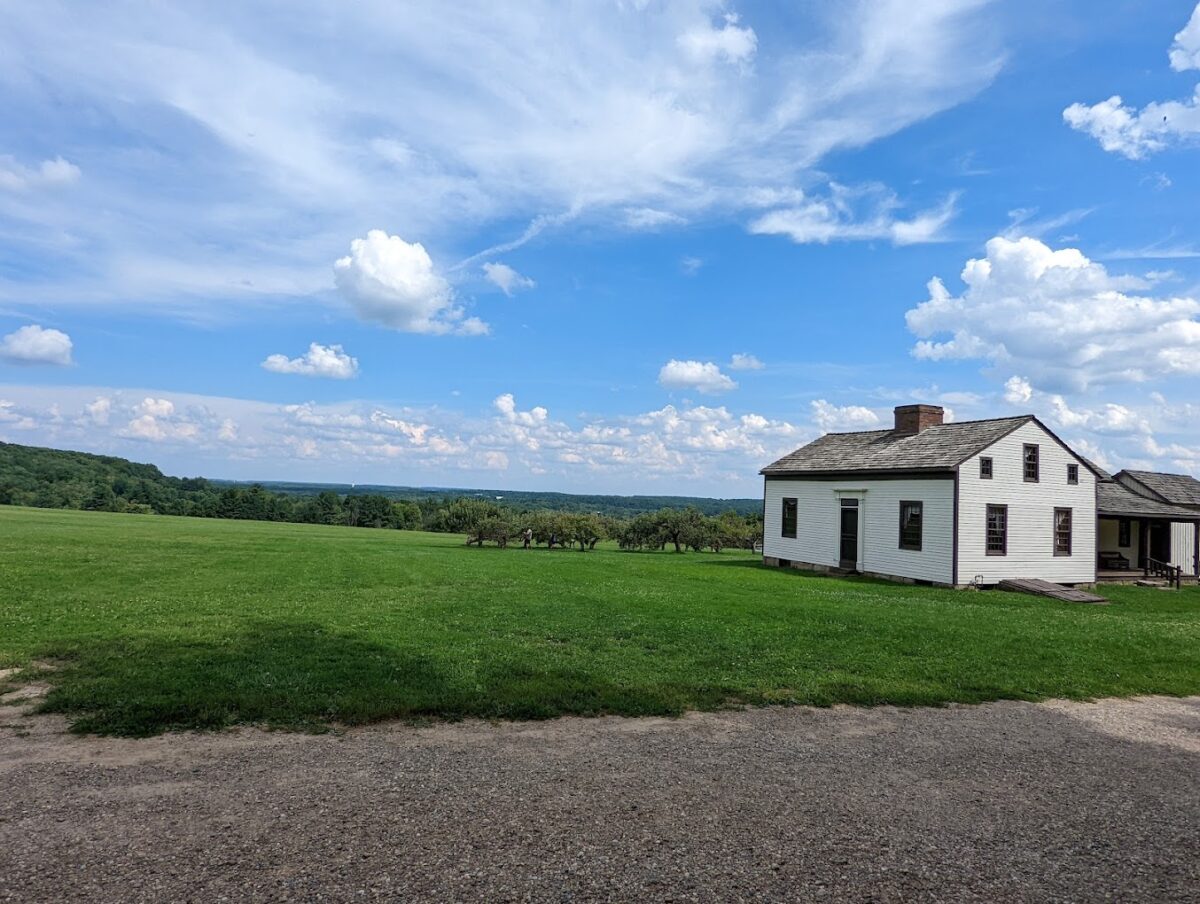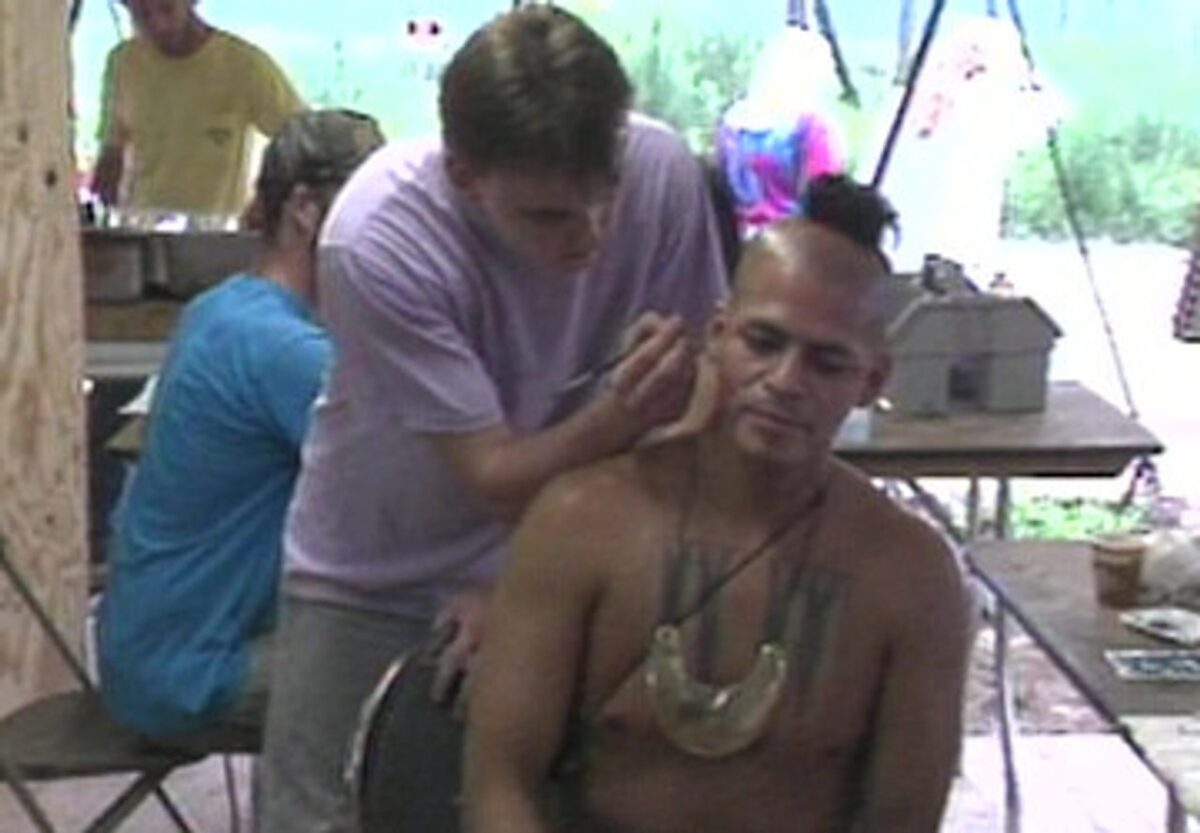Tag: Mohican

Roy King (left), Jeff Langworthy and JR Rhodebeck play a song during the open mic session at the Appalachian Acoustic Music Weekend on Friday at the Mohican Lodge and Convention Center. TOM E. PUSKAR/TIMES-GAZETTE.COM
PERRYSVILLE – The annual three-day Appalachian Acoustic Music Weekend kicked off Friday evening at Mohican Lodge and Conference Center with an open mic stage.
The event includes acoustic music all weekend (jamming throughout the lodge) and country cooking in the dining room.
The movie “The Mountain Minor” was scheduled for 2 p.m. Saturday with a concert by April Verch at 8 p.m. Saturday. Sunday’s schedule was a gospel sing at 10:30 a.m.
Acoustic jamming all weekend.
All events are free and open to the public.
Pam Hunt plays a song on an autoharp during the open mic session at the Appalachian Acoustic Music Weekend at the Mohican Lodge and Convention Center. TOM E. PUSKAR/TIMES-GAZETTE.COM
This article originally appeared on Ashland Times Gazette: Mohican Lodge sets up state for Appalachian Acoustic Music

[]{t(!0)},i.onerror=()=>{t(!1)});for(const e in s)e&&Object.prototype.hasOwnProperty.call(s,e)&&void 0!==s[e]&&i.setAttribute(e,s[e]);document.body.appendChild(i)},addAsset(e,s={}){const{async:a=!0,defer:n,useModule:d=!1,callback:c}=s;if(f[e])return void(“function”==typeof c&&c(!0));let m;if(m=i?o:r,!m||0===m.length)return;f[e]=!0;let u=m[0]&&m[0][e]&&m[0][e].mjs;d?(this.addScriptTag(u,{async:a,defer:n,type:”module”},c),m.length>1&&!i&&(u=m[1]&&m[1][e]&&m[1][e].js,this.addScriptTag(u,{async:a,defer:n,nomodule:!0},c))):(m.length>1&&!t&&(u=m[1]&&m[1][e]&&m[1][e].js),this.addScriptTag(u,{async:a,defer:n},c))},reset(){f={}}}}({isModern:false,isDev:false,lang:’en-US’,features:[],devAssets:{},prodAssets:[{“_staticFinProtobuf”:{“mjs”:”https://s.yimg.com/uc/finance/webcore/js/_staticFinProtobuf.0c5bdcae45da9ec4f59a.mjs”},”chart”:{“mjs”:”https://s.yimg.com/uc/finance/webcore/js/chart.520fea03faa3cb419df2.mjs”},”cryptoTrade”:{“mjs”:”https://s.yimg.com/uc/finance/webcore/js/cryptoTrade.6798089fc427d994b4e5.mjs”},”finBarChart”:{“mjs”:”https://s.yimg.com/uc/finance/webcore/js/finBarChart.538f8a340c2cb6354b75.mjs”},”finGaugeChart”:{“mjs”:”https://s.yimg.com/uc/finance/webcore/js/finGaugeChart.00a6a7c597326a2bd947.mjs”},”finHorizontalBarChart”:{“mjs”:”https://s.yimg.com/uc/finance/webcore/js/finHorizontalBarChart.3759f974570a40144429.mjs”},”finIcon”:{“mjs”:”https://s.yimg.com/uc/finance/webcore/js/finIcon.303dcbfc0a8c9e028f3e.mjs”},”finPlaidLink”:{“mjs”:”https://s.yimg.com/uc/finance/webcore/js/finPlaidLink.de8cef422ee826c41ae6.mjs”},”finVizChart”:{“mjs”:”https://s.yimg.com/uc/finance/webcore/js/finVizChart.a1ae48f36312bf1ea7ce.mjs”},”finYodlee”:{“mjs”:”https://s.yimg.com/uc/finance/webcore/js/finYodlee.6c5f6eaffe5a8dbb56cd.mjs”},”importantDates”:{“mjs”:”https://s.yimg.com/uc/finance/webcore/js/importantDates.3b0b31ffa9353b9b8694.mjs”},”marketSummary”:{“mjs”:”https://s.yimg.com/uc/finance/webcore/js/marketSummary.ee07a7351d988ea3c676.mjs”},”marketTime”:{“mjs”:”https://s.yimg.com/uc/finance/webcore/js/marketTime.9ddde2ddb9193240a64d.mjs”},”navigation”:{“mjs”:”https://s.yimg.com/uc/finance/webcore/js/navigation.26d5260f6ae98b2d44db.mjs”},”portfolio”:{“mjs”:”https://s.yimg.com/uc/finance/webcore/js/portfolio.bb49ee8005a508c4cc13.mjs”},”quoteSummary”:{“mjs”:”https://s.yimg.com/uc/finance/webcore/js/quoteSummary.3333a62718e8195bfe77.mjs”},”sparkLine”:{“mjs”:”https://s.yimg.com/uc/finance/webcore/js/sparkLine.be4a748c75a1f617d549.mjs”},”streamer”:{“mjs”:”https://s.yimg.com/uc/finance/webcore/js/streamer.189679b58fdea40c26ed.mjs”},”ticker”:{“mjs”:”https://s.yimg.com/uc/finance/webcore/js/ticker.b6428d6ad777e2269050.mjs”},”xrayStocks”:{“mjs”:”https://s.yimg.com/uc/finance/webcore/js/xrayStocks.3a041decb56dc5c365ee.mjs”},””:{“mjs”:[“https://s.yimg.com/uc/finance/webcore/js/portfolio.worker.a333421d7870ffcf5aed.worker.mjs”,”https://s.yimg.com/uc/finance/webcore/js/streamer.worker.aab38e33775cc0bf0abb.worker.mjs”]}},{“_staticFinProtobuf”:{“js”:”https://s.yimg.com/uc/finance/webcore/js/_staticFinProtobuf.0c5bdcae45da9ec4f59a.js”},”chart”:{“js”:”https://s.yimg.com/uc/finance/webcore/js/chart.6bc54a364b435c8a99e5.js”},”cryptoTrade”:{“js”:”https://s.yimg.com/uc/finance/webcore/js/cryptoTrade.a901d7b7b841bb62a6f3.js”},”finBarChart”:{“js”:”https://s.yimg.com/uc/finance/webcore/js/finBarChart.2b39ba2d6cd6604077c8.js”},”finGaugeChart”:{“js”:”https://s.yimg.com/uc/finance/webcore/js/finGaugeChart.25bf3473b868fa909fd9.js”},”finHorizontalBarChart”:{“js”:”https://s.yimg.com/uc/finance/webcore/js/finHorizontalBarChart.5cebe343ff14e5a223a1.js”},”finIcon”:{“js”:”https://s.yimg.com/uc/finance/webcore/js/finIcon.c0a0f64c3dae0298f8c9.js”},”finPlaidLink”:{“js”:”https://s.yimg.com/uc/finance/webcore/js/finPlaidLink.23ff8d6b705684d650d1.js”},”finVizChart”:{“js”:”https://s.yimg.com/uc/finance/webcore/js/finVizChart.3f8efbbb358084fce5d1.js”},”finYodlee”:{“js”:”https://s.yimg.com/uc/finance/webcore/js/finYodlee.da034115497a3975cedf.js”},”importantDates”:{“js”:”https://s.yimg.com/uc/finance/webcore/js/importantDates.0a99743d1d81f553ad94.js”},”marketSummary”:{“js”:”https://s.yimg.com/uc/finance/webcore/js/marketSummary.503f3c533ace40b67eb4.js”},”marketTime”:{“js”:”https://s.yimg.com/uc/finance/webcore/js/marketTime.591919fa86fd2e566de9.js”},”navigation”:{“js”:”https://s.yimg.com/uc/finance/webcore/js/navigation.a7fde8b8b6b3e410bada.js”},”portfolio”:{“js”:”https://s.yimg.com/uc/finance/webcore/js/portfolio.7325b06e91e5ff1d3cc4.js”},”quoteSummary”:{“js”:”https://s.yimg.com/uc/finance/webcore/js/quoteSummary.e98a0f20b184c33c62b8.js”},”sparkLine”:{“js”:”https://s.yimg.com/uc/finance/webcore/js/sparkLine.0413e9efc189c72a7dbd.js”},”streamer”:{“js”:”https://s.yimg.com/uc/finance/webcore/js/streamer.6bdaacb69ceabe9a4709.js”},”ticker”:{“js”:”https://s.yimg.com/uc/finance/webcore/js/ticker.42e0507f0a2cbc8ecb06.js”},”xrayStocks”:{“js”:”https://s.yimg.com/uc/finance/webcore/js/xrayStocks.afb00002fe9bfca85ec8.js”},””:{“js”:[“https://s.yimg.com/uc/finance/webcore/js/portfolio.worker.66d9d4dd5c92521470f9.worker.js”,”https://s.yimg.com/uc/finance/webcore/js/streamer.worker.d4d5837ef667fcb72479.worker.js”]}}],strings:{“AUTHENTICATING”:”Authenticating”,”BUY”:”Buy”,”BUY_FALLBACK”:”Buy {amount}”,”CANCEL”:”Cancel”,”CLOSE”:”Close”,”COIN_BALANCE”:”{coin} balance: {amount} {coin}”,”COMPANY_NAME”:”Company name”,”CONFIRM”:”Confirm”,”CONGRATULATIONS”:”Congratulations”,”CRYPTO_BUY_SUCCESS”:”You bought {proceeds} {coin} for {cost}”,”CRYPTO_SALE_SUCCESS”:”You sold {proceeds} {coin} for {cost}”,”CRYPTO_FIRST_BUY_SUCCESS”:”You made your first buy of {proceeds} {coin} for {cost}”,”CRYPTO_FIRST_SALE_SUCCESS”:”You made your first sale of {proceeds} {coin} for {cost}”,”CRYPTO_NO_COIN”:”You don’t have any {coinName} yet”,”CRYPTO_NO_COIN_INFO”:”Start purchasing coins now”,”CRYPTO_BUY_COIN”:”Buy {coinName}”,”EDIT_LIST”:”Edit list”,”REFRESH”:”Refresh”,”HIDE_HOLDINGS”:”Hide holdings”,”INSUFFICIENT_COIN”:”You have insufficient {coin} in your wallet to sell.”,”INSUFFICIENT_FUNDS”:”You have insufficient funds in your wallet.”,”SHOW_HOLDINGS”:”Show holdings”,”DAY_GAIN”:”Day gain”,”TOTAL_GAIN”:”Total gain”,”AS_OF”:”As of {time}”,”ADD_SYMBOLS”:”Add Symbols”,”CUSTOM”:”Custom”,”DELETE”:”Delete”,”DELETE_WATCHLIST”:”Delete Watchlist”,”DONE”:”Done”,”GET_STARTED_ADD_SYMBOLS”:”Get started by searching for companies to add to your new watchlist.”,”N_SYMBOLS”:”{n} symbols”,”TOP_HOLDINGS”:”Top holdings”,”SELL_FALLBACK”:”Sell all”,”SEARCH_SYMBOLS”:”Search for companies & symbols”,”SHOW_MORE”:”Show more”,”SHOW_LESS”:”Show less”,”SORT_BY”:”Sort by:”,”SYMBOL”:”Symbol”,”GET_HELP_WITH_PREMIUM”:”Get help with Premium”,”PORTFOLIO_ONBOARD_TITLE”:”Let’s build your first watchlist!”,”PORTFOLIO_ONBOARD_DESC”:”Get started by using the search bar to find your favorite companies to add to your watchlist.”,”LINK_BROKER_VISIT”:”Link your broker account by visiting”,”LEARN_MORE”:”Learn more”,”MARKETS_OPEN”:”Market open.”,”MARKET_TIME_NOTICE_CLOSED”:”As of {date} {time}. {marketState}”,”MARKET_TIME_NOTICE_CLOSED_SHORT”:”At close: {date} {time}”,”MY_WATCHLIST”:”My Watchlist”,”ORDER_ERROR_TITLE”:”There was a problem processing your order”,”ORDER_ERROR_INFO”:”Let’s get this sorted out for you”,”ORDER_PREVIEW”:”Order preview”,”ORDER_PROGRESS”:”It may take up to a minute.”,”PORTFOLIOS_TOTAL”:”Portfolios Total”,”POST_MARKET_NOTICE”:”After hours:”,”POST”:”Post”,”POWERED_BY”:”Powered by”,”PRE”:”Pre”,”PRE_MARKET_NOTICE”:”Pre-Market:”,”PRIVACY_VZ”:”Verizon Media Privacy”,”PRIVACY_YAHOO”:”Yahoo Privacy”,”PROVIDE_FEEDBACK”:”Provide Feedback”,”PROGRESS_TRACK”:”{current} of {total}”,”PRICE”:”Price”,”PURCHASE_AMOUNT”:”Purchase amount”,”RECEIVED_ORDER”:”We’ve received your order”,”REVIEW_ORDER”:”Review Order”,”SELL”:”Sell”,”SALE_AMOUNT”:”Sale amount”,”SPRED_INFO_DISCLIMER”:”The price is subjected to change.”,”TAKE_TOUR”:”Take the tour”,”TERMS_VZ”:”Verizon Media Terms”,”TERMS_YAHOO”:”Yahoo Terms”,”TRADE_COIN”:”Trade {coinName}”,”TRACK_PORTFOLIO”:”Track your portfolio”,”TRANSFER_FUND”:”Fund your Wallet”,”TRY_AGAIN”:”Try again”,”TRY_OTHER_BROWSER”:”Unfortunately broker linking is not currently supported on Chrome. Please try again with another browser”,”VERIFY_ID”:”Verify your ID for a full access”,”VIEW_ON_YAHOO_FINANCE”:”View on Yahoo Finance”,”UNLINKING”:”Unlinking your account”,”WALLET_BALANCE”:”Purchase power: {amount}”,”YAHOO_FINANCE”:”Yahoo Finance”,”YODLEE_ERROR”:”Something went wrong on our end. Please try again.”,”YODLEE_BANK_ERROR”:”Sorry, we couldn’t connect your bank account”,”YODLEE_TIMEOUT”:”Your session has timed out. Please sign in again”,”YODLEE_BANK_STATEMENT”:”Linking an account will show up on two cards: My spending and Upcoming bills.”,”YODLEE_BANK_LOADING”:”Loading”,”MIN_AMOUNT”:”You can buy minimum of $1.00″,”IMPORTANT_DATE”:”Important dates”}}); function initStreamer(){ window.finWebCore.addAsset(‘streamer’,{async:true}); } if(document.readyState === ‘interactive’ || document.readyState === ‘complete’){ initStreamer(); }else{window.addEventListener(‘DOMContentLoaded’, initStreamer);}}]]>
[]

Pauric Tighe, originally from Virginia in Co Cavan, has worked in Downey’s Bar in Cabra since his father took it over back in 2002.
Walking into the local, you’ll see a collage of photos of loyal customers, framed pictures of the Downey’s crowd with an Irish flag at Italia 90, cheques of donations they raised for Temple Street Children’s Hospital, and an Elvis Presley flag.
‘We’re the last of the Mohicans, it’s becoming harder,’ says Cabra pub owner trying to keep pints at Cavan prices
You’ll also find a Guinness Six Nations flag with a €5 sign stuck to it, letting people know that Downey’s is one of the few pubs in the capital that still sells it at that price.
But as Diageo continues to raise the price of their alcohol, it’s becoming more and more difficult to keep the pint at a reasonable price.
“We’re the last of the Mohicans, it’s becoming harder,” Mr Tighe told the Irish Independent.
“It’s good to be competitive, but we’re unique, this pub can’t be replicated anywhere else. It’s mostly due to the people who come in here, not us. They’re what make Downey’s, Downey’s.
“We’ve photographs of the customers and memorial cards of our past customers behind the bar. If these types of pubs close, they’ll only be replaced by Starbucks or some sort of coffee shop. This pub is unique to this area.
“We’re trying to get people to come out, not sit and drink at home. We’re saying we’re €5 a pint, why not give us a go one night a week, that’s our offering to people.
“Our customers are locals here in Cabra East. They’re all over the walls. This is a local Cabra pub, having decent prices encourages people to come out.
“That’s what we want, there’s no point in having an expensive drink and an empty…

7 Incredible Rural Places To Visit Near Cleveland, Ohio [] >e/4).toString(16)})};e.config=i||{},e.config.apiKey=o,e.config.workspaceId=n,e.config.environment=e.config.environment||”production”,(window.crypto||window.msCrypto)&&(e.config.viewId=t());for(var g=[“addon”,”identify”,”track”,”trigger”,”query”,”segment”,”segments”,”ready”,”on”,”once”,”user”,”consent”],r=0;r { if(!response.ok){ throw new Error(‘Comscore – Error OK. ‘ + response.status); } return response.json() }) .then(response => { const { vnd_prx_segments } = response.targeting if(!vnd_prx_segments){ console.log(‘Comscore – No Targeting Info: ‘); console.log(vnd_prx_segments); }else if( vnd_prx_segments.includes(‘999997’) || vnd_prx_segments.includes(‘999998’) || vnd_prx_segments.includes(‘999999’) ){ console.log(‘Comscore – Error code 999997: If the account is not authorized to query the passed URL’); console.log(‘Comscore – Error code 999998: If the URL has been sent for crawling/analysis. Subsequent calls to the API for the same page, will yield segments.’); console.log(‘Comscore – Error code 999999: If the URL is unreachable or cannot be categorized’); console.log(vnd_prx_segments); }else{ window.googletag.cmd.push(() => { window.googletag.pubads().setTargeting(‘vnd_prx_segments’, vnd_prx_segments) window.googletag.pubads().enableSingleRequest() window.googletag.enableServices() }); console.log(‘Comscore – Success ‘); } }) .catch(error => { console.log(‘Comscore – Error: ‘); console.log(error); }); console.log(‘fnComscore_googleTargetingData ended’); } fnComscore_googleTargetingData(); ]]> Continue reading

new Promise((resolve) => { if (window.__uspapi && ‘function’ === typeof __uspapi) { __uspapi(‘getUSPData’, 1, (uspData, success) => { if(success) { const consent = uspData.uspString.split(”)[2]; if (consent === ‘N’) { resolve(true); } else { resolve(false); } } else { resolve(false); } }); } else { resolve(false); } }); // Dispatch event for user consent window.OneTrust?.OnConsentChanged(({ detail }) => { const nxsConsentEvent = new CustomEvent(‘nxsConsent’, { detail }); dispatchEvent(nxsConsentEvent); }); // groups the user has consented to window.nxsConsentGroups = window.OnetrustActiveGroups; }) ]]> Continue reading

Published: 14:16 EDT, 27 March 2024 | Updated: 16:18 EDT, 27 March 2024
(function (src, d, tag){ var s = d.createElement(tag), prev = d.getElementsByTagName(tag)[0]; s.src = src; prev.parentNode.insertBefore(s, prev); }(“https://www.dailymail.co.uk/static/gunther/1.17.0/async_bundle–.js”, document, “script”)); DM.loadCSS(“https://www.dailymail.co.uk/static/gunther/gunther-2159/video_bundle–.css”);
David Beckham‘s iconic mohican haircut was inspired by the legendary Travis singer Fran Healy.
The professional footballer, 48, turned heads when he opted for the bold and daring look in 2001 and revealed it to the world during The World Cup.
While people may think he was the ultimate trendsetter at the time, the singer, 50, has proven he is not.
Speaking to hosts Gordon Smart and Martin Compston on the Restless Natives podcast about his new album L.A. Times, which releases July 12, he revealed he was the man behind the infamous hairdo.
He said: ‘I asked the guy who’s always cut my hair, Pete, down here at cuts and he is responsible for the fin, he was responsible for the, sort of, blondie one.

 Continue reading
Continue reading

Lake George Churches will continue their annual tradition of Walking the Way of the Cross along the Village streets on Good Friday and celebrating Easter with a sunrise service on the lake shore.
The Walking of the Way of the Cross will begin at noon on Friday, March 29. The observance will start at Sacred Heart Catholic Church on Mohican Street and travel to St. James Episcopal Church on Montcalm Street. The procession will continue to Lake George Community Methodist Church and end at Caldwell Presbyterian Church, both also on Montcalm Street.
Retracing Jesus’ final footsteps is a Christian tradition that dates back to the 4th Century when pilgrims would travel to the Holy Land to walk the original Way of the Cross. The path is marked with 14 stations beginning with Pontius Pilate’s Court condemning Jesus to death and ending with Jesus being laid in his tomb. During the season of Lent, Christians worldwide celebrate the Stations of the Cross each Friday.
 The sun rises over Lake George.
The sun rises over Lake George.
On Easter Sunday, the four Lake George Churches will celebrate the Resurrection with an ecumenical Easter Sunrise Service on MacDonald Pier in Shepard Park. The service will begin at 6:30 a.m. A free continental breakfast at Caldwell Presbyterian Church will follow the Easter Sunrise Service.
Featured image: Parishioners walk The Way of the Cross on Montcalm Street, Good Friday 2019.
Related

MOUNT VERNON — Local officials are working to make a connector trail between the Kokosing Gap and Mohican Valley trails a reality.
Representatives of Danville, the Knox County Park District, the Knox Community Foundation, the Area Development Foundation, and the Kokosing Gap Trail Board met with the county commissioners on March 14 to review preliminary plans.
The KGT ends at Richards Street in Danville, and the MVT begins at East Street. Connecting the two is one initiative in the village’s strategic plan.
“Typically, trails would follow the railroad bed, but Danville Feed and Supply has a building on the railroad bed,” explained Sam Filkins, ADF vice president.
“We looked at using an existing bridge on the state route, but it wasn’t wide enough to do a bike trail, and we would have to build a new bridge. That would cost too much.”
Lisa Loyd of the KCF added, “We think the easiest way is to build a bridge over the creek behind the feed mill in Danville.”
Plans call for cyclists to come off of the KGT, head north on Richards Street to Tilton Street, and then east to South Market Street.
Cyclists will cross South Market onto village-owned land, skirt the perimeter of what will become Thomas Wayne Cottrell Jr. Memorial Park, cross the new bridge, and access the Mohican Valley Trail.
The connector trail will be a raised boardwalk over the wetlands areas.
The crosswalk on South Market will include warning lights and roadway striping.
Connector trail brings commerce
Filkins said Danville is one of the few villages that import workers. More than 32 percent of them are in retail and food services.
“They would benefit from tourism and commerce,” he said. “The reality is we’re not able to build a large industrial place in Danville,…

response.json()) .then(data => data.uuid) .catch(error => console.warn(‘There was an error!’, error)) : Promise.resolve(uuid) ).then(uuid => { console.log(‘uuid from ID ppid api:’, uuid); var date = new Date(); date.setTime(date.getTime() + (180 * 24 * 60 * 60 * 1000)); var expires = ‘expires=’ + date.toUTCString(); var path = ‘path=/’; var cookieString = ‘SUID=’ + [uuid, expires, path].join(‘; ‘); var sameSiteSecure = undefined ? ‘; SameSite=None; Secure’ : ”; console.log(‘ppid cookie string ‘, cookieString + sameSiteSecure); document.cookie = cookieString + sameSiteSecure; if (uuid) { window.dataLayer.push({ ‘event’: ‘user_id’, ‘user_id’: uuid, ‘test’: true }); } }) ]]> ]]> -1) { isBlocked = true; } return isBlocked; } })(); ]]> 0 ? adsBlocked : true; // If height ]]> -1) { return “gallery”; } else if (path.indexOf(“/weather”) === 0) { // Includes all subsections of /weather, per request return “weather”; } else if (path.indexOf(“/traffic”) === 0) { // Includes all subsections of /traffic, per request return “traffic”; } else if (path.indexOf(“/watch”) === 0 || path.indexOf(“/watch-beta”) === 0) { // Includes watch and watch-beta pages return “watch”; } // All other sections should report as simply “section” return “section”; } ]]> -1; } // command = ‘getUSPData’, version = 1, callback = function(uspData: uspdata, success: boolean) window.__uspapi = function (command, version, callback) { if (command === ‘getUSPData’ && version === 1) { if (isFullMeasure() || getPrivacyKVP()) { // enable via KVP or if the site is fullmeasure.news // check trustarc for privacy info var uspString = getTrustArc(); if (uspString) { // if the uspString was created and returned properly // Then perform callback with correct object var uspData = { version: version, uspString: uspString }; return callback(uspData, true); } } } // Case where command !== getUSPData || uspString returns null || version !== 1 || !usPrivacyEnabled // call callback…
Continue reading

